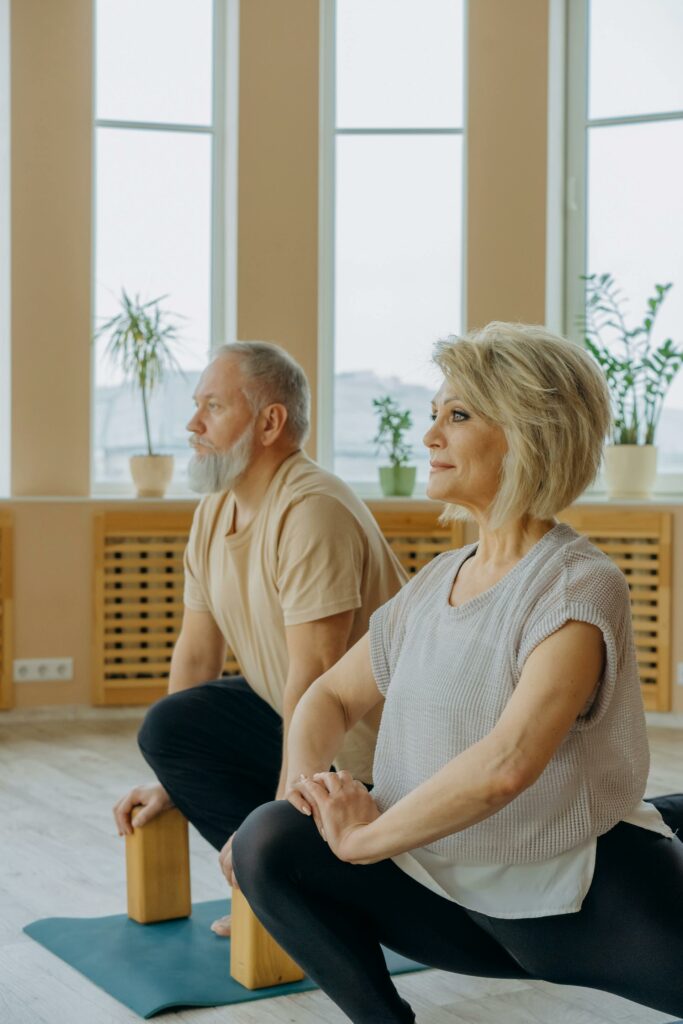We all want to feel a little better; to let the anxiety flow, the sadness melt, allow anger or frustration to jel and give a little wiggle room for peace and joy to rest. When you come to the mat, you bring who you are and how you feel. When you are on the mat, you find who you can be. You also find how you can be. You find you can be calm. You can be strong. You can be peaceful, balanced, and free.
Yoga is part movement, part stillness, and part of everything in between. Yoga strengthens us, challenges us, and builds power and confidence in us.
Movement brings us joy. It fosters connection with ourselves and with others. Movement offers a transformative experience and serves as a tool for healing, particularly in the context of trauma and mental well-being. Trauma work is partly a cognitive process, and part a somatic process. A process where we work with the body. Sometimes we need to mentally process the feeling and sometimes we need to physically process it as well.
Yoga is a valuable modality for addressing trauma, aiding emotional regulation and helping one to manage emotions. Yoga also complements therapy and can help support healing without actually talking about the trauma. Healing from deep trauma involves four key areas: therapy, biology, movement/bodywork, and self-care/life skills. My focus lies in movement and self-care practices.
Yoga helps by working with the body
 When you come to the mat, you come to stillness, you move; sometimes you push, sometimes you pull back. In the process your movements strengthen not only your muscles but also your emotional capacity. In this process, you learn who you are, where you stand, and develop the strength to stand through the challenges of life.
When you come to the mat, you come to stillness, you move; sometimes you push, sometimes you pull back. In the process your movements strengthen not only your muscles but also your emotional capacity. In this process, you learn who you are, where you stand, and develop the strength to stand through the challenges of life.
Yoga postures take you through the developmental movement sequences of early life. Individuals with trauma may not have completed all the sequences, or they may be stuck somewhere in the sequence. Practicing yoga can help you flow through some of the developmental sequences in a fun and meaningful way.
Yoga helps you release bracing patterns created by trauma. When trauma shows up in the body, bracing patterns are created. These patterns occur for protection. They may show up in your head, neck, shoulders, breath, or arms. You may notice you have a forward posture, protecting your heart. Through a trauma-informed yoga practice you can again rewire your nervous system to let go of these patterns, finding healthy patterns that allow you to have balance and more freedom in your movement.
Yoga helps balance your energy
When you practice yoga you also stimulate your energy. Through a variety of postures you may increase or decrease the flow, depending on the focus of the practice. Then we remove blockages so the energy can move.
Everything we do with the human body requires energy. We need energy to work, to play, to learn, to digest food, and to heal. Our cells need energy to do their work, whether healing, growing, or removing waste. Energy is part of life. Through a yoga practice we help you stimulate, direct, and use energy to balance your system.
In the end yoga helps improve your energy levels and you become more empowered to be your true self. In finding your true self, you find transformation.
Yoga helps you manage stress and anxiety
 In the flow of life, we may experience anxiety or depression. The National Institute for Mental Health (NIMH, 2017) states nearly one in three adults experiences anxiety at some point in their life. The prevalence of a major depressive episode in adults in the U.S. is 8.3%. Research shows that yoga can help you improve these emotions and help you feel better.
In the flow of life, we may experience anxiety or depression. The National Institute for Mental Health (NIMH, 2017) states nearly one in three adults experiences anxiety at some point in their life. The prevalence of a major depressive episode in adults in the U.S. is 8.3%. Research shows that yoga can help you improve these emotions and help you feel better.
Yoga trains the mind to be in the moment and helps you stay present. In the present moment you create space. You create internal safety. You teach your nervous system that there are options that you can access other than the big emotions that can take you into a frenzy or depression.
On the mat we work with the postures, the breath, the senses, and the mind to help you balance your nervous system. Soon these practices become second nature. You will learn when you are feeling out of balance and how to bring yourself back to balance.
Yoga helps you improve posture and build strength
Did you know, the taller you stand the more confident you feel? Your posture can influence how you feel!
When your body is strong, your posture improves. When you feel strong you also feel empowered! And feeling empowered is important in healing from trauma.
Research shows that your posture can directly affect your mood and self-confidence. A good yoga workout can do wonders for your posture as you strengthen your core, improve your body awareness, and increase your range of motion. As you move on your mat you release muscle stiffness, your balance, strength, and flexibility improve, and in the process you gradually improve your posture.
All this work on the mat releases muscle tension, increases your lung capacity, and allows other vital organs to function better. You take deeper breaths. You feel strong and grounded. When your posture improves, digestion improves, and the circulation of blood throughout the body increases. As you improve your posture, you not only feel more confident, you feel freer, and healthier.
All forms of yoga can help you improve your posture.
Yoga helps you rest and restore
 Slowing down can feel challenging. We are all used to the continued pressure to be on the go and get things done. Generally when we exercise, we feel the same. The harder we work, the more benefit we feel we gain.
Slowing down can feel challenging. We are all used to the continued pressure to be on the go and get things done. Generally when we exercise, we feel the same. The harder we work, the more benefit we feel we gain.
However, this continued pushing of the body uses valuable biological resources that must be replenished on a daily basis. Living with reduced resources opens the door to chronic physical and mental health problems. By aligning your yoga practice with your physical, emotional, and biological needs you can restore your resources, resulting in increased energy, and improved health.
Slowing down is a necessary part of our daily life. Did you know that slowing down can actually be energizing? Yet it can also feel hard to do. Restorative yoga practices provide a wonderful way to help you slow down and nourish the body.
Your body works in a bidirectional manner. So the way you move affects how you feel and think, and the way you feel or think, affects how you move. When you move ways that nurture your body, you feel better. When you feel better, you want to move more.
Yoga connects you with community
Yoga provides us with community; community with yourself and community with others. Through your yoga practice you explore the many parts of you that make you the interesting person that you are. In a yoga class you join many like minded individuals who support you in your healing journey and help you coregulate and balance your nervous system.
In community you are supported in our healing. You grow individually and together. A yoga community can provide a space free of judgment; a place of acceptance of self and of others.
Although your yoga practice is done individually on your mat, you unite in a community through our shared love of yoga. Our passion for yoga is synchronized, as is our breath, our movement, our struggles, and gains. Together, we find balance.
It is in this community that we truly heal. The community we create is as nourishing as the yoga practice itself. It is in the connection that we feel a sense of belonging, security and safety. We carry this embodied sense of safety and support as we journey from the mat into life.
The beauty is that this community of lovely people transcends any boundaries of race, religion, or culture. We become united and heal individually and together.
Through community and connection we improve not only our own well-being, but extend this to others around us, building stronger and healthier communities. This is what we truly need.
In continuing my journey understanding the complexities of trauma, I received several certifications in movement therapies including my 500 RYI certification, specialized yoga certifications including trauma, and Somatic Therapy certification, enabling me to tailor sessions to individual or group needs to support mental health. I would love to work with you on your journey to find peace and joy.
I can help you choose a yoga style that will train your body and support your mental health goals.
References:
Bhargav, H., George, S., & Varambally, S. (2022, April 26). Yoga and mental health: What every psychiatrist needs to know. Cambridge University Press. https://www.cambridge.org/core/journals/bjpsych-advances/article/yoga-and-mental-health-what-every-psychiatrist-needs-to-know/D1B28ED8D55B6B01385A7416B34DE6F1
National Institute of Mental Health. (2023). Major Depression.
https://www.nimh.nih.gov/health/statistics/major-depression#:~:text=disorders%2C%20or%20medication.-,Prevalence %20of%20Major%20Depressive%20Episode%20Among%20Adults,8.3%25%20of%20all%20U.S.%20adults.
https://www.nimh.nih.gov/health/statistics/any-anxiety-disorder
Grabara, M., & Szopa, J. (2015). Effects of hatha yoga exercise on spine flexibility in women over 50 years old. The Journal of Physical Therapy Science, 27(2), 361-365. doi: 10.1589/jpts.27.361
Harvard Health Publishing, (2024, April 29). Yoga for better health. Harvard Medical School. https://www.health.harvard.edu/staying-healthy/yoga-for-better-mental-health

